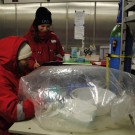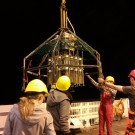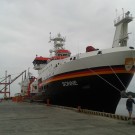Being able to test brand new technology is always exciting. The Ecotone Scientific UHI (Underwater Hyperspectral Imager) brought from NTNU in Norway was finished only a week before the Sonne disembarked from Guayaquil. It is the first UHI to be designed for deep sea use (6000m). Any untested equipment will present some initial challenges. During […]
“Why are you doing this research?” – Questions of the International School in Bremen
Questions from a school class A number of the scientists and crew taking part in SO242-2 are based in Bremen, Germany. We have received a number of interesting questions from year 6 students attending the International School Bremen, sent to us by their teacher, Martyn Robinson-Slater. We in this blog will try and answer some […]
What lives, breathes – New technology to measure respiration in the deep sea
Today we present the benthic crawler “Tramper” and it first steps at the seafloor in 4150m water depth. Tramper was designed and constructed within the HGF Allianz ROBEX (http://www.robex-allianz.de/) to measure oxygen concentration in the sediment autonomously over a longer period (up to one year). During this expedition we performed the first in situ test […]
Only dust in the wind? How we trace particles suspended by human activities at the deep-sea floor
In addition to a direct disturbance by an industrial collection of nodules at the seafloor, potential impacts of nodule mining are connected to the associated generation of sediment plumes and their dispersal. This may vastly extend the area that is affected by mining activities. Deep-sea sediments are typically very fine and easily eroded – it […]
Toolboxes at the seafloor
Our ROV (remotely operated vehicle) substitutes our eyes and arms at depth, but the amount of instrumentation it is able to carry (the so-called payload) is limited to the available space and weight of the payload in water since the ROV is kept buoyant by its own floatation (the yellow syntactic foam on the upper […]
Polar suits in the Pacific – sediment sampling for geochemical analyses
¡Hola! We are Seinab and Sophie from Jacobs University Bremen. It is the first big research cruise for both of us and we are excited to be part of it. Instead of looking at sea cucumbers and worms, we work with mud. Here we would like to give an introduction to the geochemical sampling we […]
How to study small organisms dwelling the seabed
Among all the amazing high-tech equipments that are being used in this SO242/2 Sonne cruise, such as the OFOS (Ocean Floor Observation System), the ROV (Remotely Operated Vehicle) and Landers measuring different environmental conditions at the seafloor, I present you a very traditional equipment used ubiquitously in deep-sea research: the Multicorer, or the MUC, as […]
Tracking the impact on Deep Sea Life
The SO242-1 cruise used an Autonomous Underwater Vehicle (AUV) to visually and acoustically inspect and map the ploughmark traces on the seafloor made by the DISCOL experiment in 1989. During SO242-2 we are using their survey data to plan a series of close up studies of the seafloor using the new Ocean Floor Observation System […]
What are you working on?
Before my shift in the lab begins I went for a walk around the ship. In the first laboratory I find Tanja and Dick (NIOZ) testing whether the algae injector of their deep-sea incubator works properly and does not release the algae before the instrument reaches the seafloor. For the test they use tea because […]
SO242-2 Back to DISCOL
With the second expedition the scientific crew on board changed, because the scientific focus is different to the first leg. This brought me on board of the “SONNE”. Here I will work as a lab assistant and I will try my best to report about the expedition in my free time. Right in the middle […]








